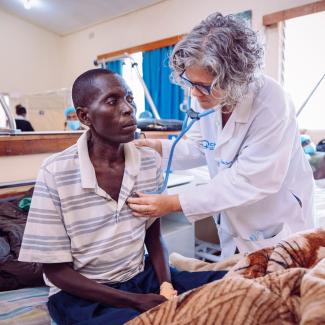A regular feature at Think Global Health will be sharing the statistics that convey the ways in which health influences and interacts with broader social, economic, and demographic trends. These numbers will help you understand in quantitative terms the global growth of cities, the mass migration of people, the outcomes of a warming climate, the critical trends in agriculture, the global expansion of supply chains, and the empowerment of women and girls. For our inaugural piece, we will focus on the basics.
Environment
$5.7
The cost associated with health damage from ambient air pollution is estimated to be $5.7 trillion, equivalent to 4.8 percent of global GDP in 2016. Source: World Bank Group
9
Estimated premature deaths (in millions) globally caused by pollution in 2015, accounting for 16 percent of all global deaths worldwide. Source: The Lancet Commission on pollution and health
8
The number of year in the last decade that were designated the hottest year on record. Source: NASA
118.4
Temperature (°F) in New Delhi on June 10, a record for the city reached amid 2019 heat wave. Source: New York Times
Poverty
$1.90
Threshold income per day for those living in extreme poverty (in 2011 purchasing power parity (PPP) dollars). Source: World Bank
1.9
Estimated number of people (in billions) who were living in extreme poverty at $1.90 level, in 1990. Source: World Bank
589
Estimated number of people (in millions) who were living in extreme poverty at $1.90 level, in 2019. Source: World Bank
6 of 10
Number of extremely poor people who live in middle-income nations. Source: New York Times.
Trade
29.3%
Exports of goods and services as a share of GDP, 2017. Source: World Bank Group
48%
Share of that low- and middle income countries represent in global trade, 2014. Since 1985, that share has doubled. Source: World Bank Group
50
Number of preferential trade agreements that existed in 1990. Source: World Bank Group
301
Number of preferential trade agreements that existed in 2019. Source: World Trade Organization
1995
Founding of the World Trade Organization (WTO)
17
U.S. free trade deals with pharmaceutical protections that go beyond those in WTO agreements. Source: Bollyky & Kesselheim
Governance
10
Percent annual growth in international development assistance for health, 2000-2010. Source: IHME
1.3
Percent annual growth in international development assistance for health, 2010-2018. Source: Dieleman et al.
1851
First International Sanitary Conference convenes in Paris. Source: Fidler
40
Years since WHO officially certified the eradication smallpox on December 9, 1979. Source:
14.6
Millions of people on antiretroviral treatment funded by the President's Emergency Plan for AIDS Relief (PEPFAR), the U.S. government's response to the global HIV/AIDS epidemic.
1948
World Health Organization founded.
2
Percent of international development assistance of health that goes to the cancers, cardiovascular diseases, and other noncommunicable diseases that cause the majority of death and disability in low- and middle-income countries. Source: IHME
Food
820
Millions of people suffering from undernourishment worldwide, which is roughly one in every nine people. Source: FAO
25
Percentage decline in the number of people suffering undernutrition since 2005. Source: FAO
1/3
Share of food produced for human consumption that is lost or wasted annually— approximately 1.3 billion tons. Source: FAO
70
Percentage of freshwater use that goes to agriculture globally. Source: World Bank Group.
2
Billion people are overweight or obese globally, as of 2015. Source: NEJM
Urbanization
55
Share of world's population residing in urban areas in 2018. Source: UN World Urbanization Prospects.
90
Expected percentage contribution of Africa and Asia to global urban growth between 2018 and 2050. Source: UN World Urbanization Prospects.
2
Projected number of people (in billions) who are expected to be living in slums by 2030. Source: Lancet.
Aging
2018
The first year when the number of people over age sixty-five outnumbered people under age five globally. Source: UN Population Prospects.
62
Percentage of the population under age 25 in sub-Saharan Africa. Source: UN Population Prospects
2039
Year when the working age population (25-64 years) of Latin America is expected to peak. Source: UN Population Prospects
35%
Percentage decrease expected in the number of women between the ages 20 and 40 in China by 2050. Source: New York Times.
Gender
132
Millions of girls out of primary and/or secondary school worldwide, in 2016. Source: UNESCO
303,000
Women who die from complications in pregnancy or childbirth each year. Source: WHO et al.
21
Proportion of women who have an unmet need for modern contraception in sub-Saharan Africa. South Asia has the absolute number of women (70 million) with unmet need for contraception. Source: Guttmacher Institute
2.7
Women (in billions) who are legally restricted from same job choices as men. Source: World Bank Group.
Migration
258
Millions of international migrants in 2017. Source: IOM
3.4
Share that international migrants represent of global population in 2017. Source: IOM
70.8
Millions of people forcibly displaced worldwide in 2018, the highest levels of displacement on record. Source: UNHCR
15.9
Millions of refuges living in “protracted situations,” which UNHCR defines as one in which twenty-five thousand or more refugees from the same nationality have been in exile for five consecutive years or more in a given host country. Source: UNHCR


